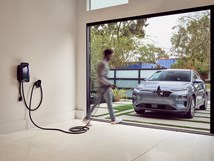Japan Tests Truck Platooning
Four of Japan’s makers of commercial trucks are testing multi-vehicle platooning systems on Tokyo area expressways.
Four of Japan’s makers of commercial trucks are testing multi-vehicle platooning systems on Tokyo area expressways.
Platooning enables trucks to automatically follow a lead vehicle driven by a trained human driver. Doing so reduces fuel consumption and traffic congestion.
The Japan tests are being conducted by Hino, Isuzu, Mitsubishi Fuso and Volvo, The Nikkei reports. Trading house Toyota Tsusho is managing the project on behalf of the country’s Ministry of Economy, Trade and Industry.
Similar tests have been conducted for more than six years in Europe and more recently in the U.S. and U.K.
The demonstrations in Japan involve groups of three 12-meter-long trucks traveling only 35 meters (115 feet) apart at 80 kph (50 mph). Each vehicle has a human driver on board. But the goal is to have two unoccupied trucks following the conventionally operated lead vehicle. The Nikkei says developers expect to achieve that result in 2020 and begin marketing the automated system by 2022.
Participating trucks are fitted with linked adaptive cruise control, cameras and laser sensors. The configuration enables the entire convoy to respond in lock step to traffic conditions.
RELATED CONTENT
-
Jeeps Modified for Moab
On Easter morning in Moab, Utah, when the population of that exceedingly-hard-to-get-to town in one of the most beautiful settings on Earth has more than doubled, some people won’t be hunting for Easter eggs, but will be trying to get a good look at one of the vehicles six that Jeep has prepared for real-life, fast-feedback from the assembled at the annual Easter Jeep Safari.
-
On Electric Pickups, Flying Taxis, and Auto Industry Transformation
Ford goes for vertical integration, DENSO and Honeywell take to the skies, how suppliers feel about their customers, how vehicle customers feel about shopping, and insights from a software exec
-
GM Develops a New Electrical Platform
GM engineers create a better electrical architecture that can handle the ever-increasing needs of vehicle systems








